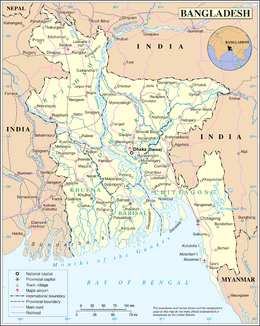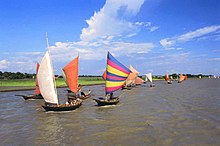This is an old revision of this page, as edited by 2.31.252.148 (talk) at 19:37, 20 November 2015 (→Railways). The present address (URL) is a permanent link to this revision, which may differ significantly from the current revision.
Revision as of 19:37, 20 November 2015 by 2.31.252.148 (talk) (→Railways)(diff) ← Previous revision | Latest revision (diff) | Newer revision → (diff)
Transport in Bangladesh is an important part of the nation's economy. Since the liberation of the country, the development of infrastructure within the country has progressed at a rapid pace, and today there is a wide variety of modes of transport by land, water and air. However, there is significant progress still to be made to ensure uniform access to all available transport.
Ground transport
With continued economic growth and development, Dhaka, the capital of Bangladesh is beginning to experience massive traffic congestion. Today, this is causing extreme frustration to the inhabitants of the metropolitan which is the largest and most crowded city of the nation. Many government and public transport agencies drafted policies, undertook projects and implemented programmes to solve these problems. For example, the Dhaka Integrated Transport Studies conducted by the Ministry of Planning in 1991-1994 found that not only did the uncoordinated activities of Dhaka City Corporation (DCC), Rajdhani Unnayan Kartripakkha (RAJUK) and Bangladesh Road Transport Authority (BRTA) not yield the desired effects or alleviate the problems but also that there was no single organisation responsible for improving the transport and traffic problems of the city.
With financial assistance from the World Bank, in 1998, Bangladesh Government created the Dhaka Transport Coordination Board. An urban transport plan was commissioned with the US Consulting Group Louis Berger and Bangladesh Consultant Ltd (BCL). The plan, launched in 2008, laid out a comprehensive transport plan for the Greater Dhaka City and its adjoining areas, such as Tongi, Gazipur, Savar, Narayanganj, Keraniganj, Narshingdi and Manikganj, covering around 1,530 square miles. The plan looked at 15 Key Policy issues including safety, pedestrian preferences, public transport, non-motorised transport, travel demand management, mass transit systems, etc. Almost 70 different policy recommendations were produced under these 15 issue areas. 10 comprehensive transport strategies were then evaluated, using a base case of no Bus Rapid Transit (BRT) or metro service and exploring many alternative combinations. Finally the adopted plan included roads in addition to using a 3 Line Mass Rapid Transit (MRT) and the 3 Line BRT. Furthermore, the plan included provisions for 54 new roads in and around the city, 3 part elevated expressways and a circular waterways programme.
Traffic jams
With Bangladesh's huge population and current infrastructure, frequent traffic jams waste valuable fuel and time and makes travel very unpleasant and difficult. Furthermore, it makes the existing public transport very inefficient and most importantly adds unbearable and unsafe levels of noise and hazardous air pollution to an already unregulated country. The noise levels and pollution cause stress in most people and lead to many life-threatening medical conditions such as cardiovascular diseases and blood pressure related ailments.
Traffic congestion changes during the day, and planning for trips is becoming impossible. Not only do commuters lose valuable time stuck in traffic, they have to leave early in hopes of making up for or altogether avoid a traffic jam. Conversely they have to wait for others trapped in the congestion, which greatly affects the daily productivity. This is something that affects everyone irrespective of their social or economic status. The current infrastructure also poses great problems for the elderly and youth. With the constriction of cars and other vehicles, old and young people lack independence and means that their escorts also waste valuable time. Walking constitutes a major mode of travel among the low-income majority. However, this majority of pedestrians are consistently ignored in the planning of transport. As a result of the unplanned and overwhelming traffic situation, people prefer walking and started using bicycles also, which have become efficient transport systems but risk their lives on the dangerous streets. Almost 80% of all traffic fatalities in the city of Dhaka alone involve pedestrians being hit by a fuel based vehicle. Private cars, a mere 4% of the total vehicles on the roads, represent vehicles which take around 70% of the road space. Public transport needs to be stressed in any future policy. Although, the change to Compressed Natural Gas (CNG) cars saved over 4,000 premature deaths in 2009, their cheap price has spiked the total numbers of cars on the streets though the recent prices hikes of CNG may have effected the spike. This has led to a decrease in the amount of natural gas available for other purposes.
Railways
Main article: Bangladesh Railway
Railway acts as an important method of mass transport in Bangladesh. Many districts of the country are connected via railways. Bangladesh Railway was mostly inherited from the British-established Assam Bengal railway system after the partition of India in 1947. Bangladesh Railway's headquarters are located in the southern port city of Chittagong, which had historically been the south-eastern terminus of the Assam-Bengal Railway. After independence from West Pakistan in 1971, only a small length of new tracks were laid out.
As of 2005, the total length of railway is 2,706 kilometres (1,681 mi). Of that, 923 km (574 mi) are broad gauge (1676mm) tracks (mostly in the western region), and the remaining 1,822 km (1,132 mi) are meter gauge tracks (mostly in the central and eastern regions). The gauge problem is being addressed by adding third rails to the most important broad and meter gauge routes, so that they become dual gauge.
A major road-railway bridge over the Jamuna River opened in 1998 to connect the previously isolated east and west railway networks.
The border between India and Bangladesh cuts across railway lines, forcing them into the other country for short distances. This complicates border controls such as passport validation.
Waterways


There are 5,150–8,046 km (3,200–5,000 mi) of navigable waterways (includes 2,575–3,058 km or 1,600–1,900 mi of main cargo routes).
Because of Bangladesh's many rivers, ferries are a major form of transportation. These ferries are notoriously dangerous. They are often overloaded, and they continue to operate during rough weather. Hundreds of people die each year in ferry accidents. Many types of boats are also used for transportation.
Pipelines
As of 2013 Bangladesh has approximately 2,950 km of natural gas pipelines.
Ports and harbors
- Chittagong; Port of Chittagong; Chittagong Port Authority - east coast
- Dhaka - River port
- Mongla Port
- Sonadia - proposed
- Payra U/C
- Narayanganj-River port
- Baghabari- River port
- Ashuganj- River port
Merchant marine
Portal:Nautical/Fleet/Bangladesh
Aviation
Airlines
Main article: List of airlines of BangladeshBiman Bangladesh Airlines is the national airlines of Bangladesh which commenced operation in 1972. The other Bangladeshi registered passenger airlines are NovoAir, Regent Airways and United Airways. All four of these airlines have a hub at Hazrat Shahjalal International Airport in Dhaka and operate both domestic and international flights Dhaka, with the exception of NovoAir which only offers domestic services.
Airports
Main article: List of airports in BangladeshThere are currently three international airports in Bangladesh: Hazrat Shahjalal International Airport in Dhaka, Shah Amanat International Airport in Chittagong and Osmani International Airport in Sylhet. All three international airports have direct connections to a number of destinations in the Middle East while Hazrat Shahjalal International Airport has services to the wider Asian region and Europe. In addition to the international airports there are also five domestic airports in Barisal, Cox's Bazar, Jessore, Rajshahi and Saidpur with almost all services from these airports either bound for or originating from Dhaka.
References
- Sunny, Sanwar (2011). Green Buildings, Clean Transport and the Low Carbon Economy: Towards Bangladesh's Vision of a Greener Tomorrow. Germany: LAP Publishers. ISBN 978-3-8465-9333-2.
{{cite book}}: Cite has empty unknown parameter:|coauthors=(help)
- "Baumaschine Ankauf germany provides to Bangladesh". LKW Ankauf. Retrieved 5 May 2015.
- Sunny 2011, p. 9
- "Lkw verkaufen from Germany". Retrieved May 5, 2015.
- Sunny 2011, p. 234
- Bangladesh Transport Website FAQ
- https://www.cia.gov/library/publications/the-world-factbook/geos/bg.html. CIA World Factbook. 2013
- "Aristocrat Pokies Australia". Retrieved 10 June 2015.
![]() This article incorporates public domain material from The World Factbook. CIA.
This article incorporates public domain material from The World Factbook. CIA.
External links
| Bangladesh articles | |||||||||||||||
|---|---|---|---|---|---|---|---|---|---|---|---|---|---|---|---|
| History |
| ||||||||||||||
| Geography | |||||||||||||||
| Politics |
| ||||||||||||||
| Economy |
| ||||||||||||||
| Society |
| ||||||||||||||